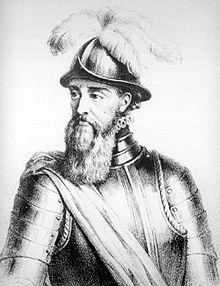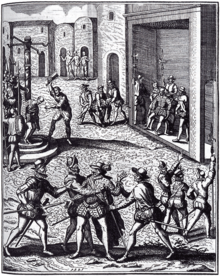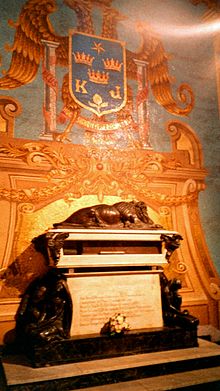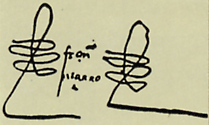Francisco Pizarro
Francisco Pizarro González [ fɾanˈθisko piˈθaro ] (* 1476 or 1478 in Trujillo , Extremadura ; † June 26, 1541 in Ciudad de los Reyes, today's Lima ) was a Spanish conquistador who with his three half-brothers and his partner Diego de Almagro the empire the Inca conquered .
Life
origin
Pizarro was the illegitimate son of a military officer, Captain Gonzalo Pizarro. He grew up with his mother, a maid, in Trujillo. On his father's side, he had three half-brothers: Hernando, born in wedlock, and Gonzalo and Juan . He also had a maternal half-brother, Francisco Martín de Alcántara . All four brothers later followed him to America. Pizarro worked in the fields, he never learned to read or write.
In the Caribbean
At the age of 19 Pizarro left his native Trujillo. Little is known of his next few years. In 1502 he came to the New World and until 1509 settled on the island of Hispaniola , in what is now Haiti . He took part in battles against the Taíno Indians. In 1509 he took part in an expedition by Alonso de Ojeda to the Caribbean coast of today's Colombia. Ojeda founded the settlement of San Sebastián on the Gulf of Urabá , but hunger, disease and hostile Indians decimated the Spanish expedition. Eventually Ojeda returned to Santo Domingo for help, leaving the settlers under Pizarro's command. Pizarro held out for fifty days, as ordered. When Ojeda did not return, he set off with his men on the return trip. He met and joined the expedition of Martín Fernández de Enciso . After a mutiny, Vasco Núñez de Balboa took command of Enciso's expedition and founded a settlement in Darién .
In 1513 he took part in Balboa's expedition across the Isthmus of Panama , where they were the first Europeans to reach the Pacific Ocean westward . Pizarro became a citizen of the city of Panama, founded on the Pacific Ocean, in 1519 , where he earned a reputation as mayor and encomendero and made a small fortune.
Exploring the Pacific
In 1522 there were vague rumors about a rich country called Biru further south. Probably Pizarro also learned of the conquest of the Aztec Empire by his distant relative, Hernán Cortés . Pizarro had something similar in mind for himself. In 1524 he signed a contract with Diego de Almagro and the priest Hernando de Luque to find this land together.
In November 1524 he set out with a small brigantine and 80 men on an expedition along the northwest coast of today's Colombia. The trip was not very successful: the expedition suffered from a lack of food, got into fights with hostile Indians, in which several Spaniards lost their lives and Pizarro was wounded several times without finding the riches hoped for. Almagro, who followed in a second ship, also got into fighting and lost an eye in the process.
Panama's governor Pedrarias Dávila was reluctant to approve a second expedition to which Pizarro and Almagro set out in early 1526. The expedition was similar to the first one with fighting, hunger and disease, in which over a hundred Spaniards were killed. After the voyage had lasted over a year, it was decided in May 1527 that Pizarro should wait with a large number of the men on Rooster Island in Tumaco Bay , while Almagro should get supplies in Panama. However, Governor Pedrarias Dávila did not want any more bloodletting of his colony and dispatched Captain Juan Tafur to Rooster Island with orders to bring all the men back. When Tafur arrived on Hahneninsel in August, he was happily welcomed as a savior. Pizarro, however, refused to go back in defeat and convinced twelve other men to follow his example. These were later known under the names "Thirteen of the Rooster Island" ( trece de Gallo ) and "Glorious Thirteen" ( trece de la fama ).
The thirteen held out for another seven months - first on Hahneninsel and then on the island of Gorgona, which is further out to sea and thus more protected . Finally Almagro appeared and brought reinforcements - the governor had allowed the expedition to continue for six months. The further journey south was finally more successful. One reached Tumbes, in the north of today's Peru, which was already on the edge of the Inca Empire, and was warmly received there. Gifts were exchanged and they returned to Panama with gold, lamas and two Indian translators .
Capitulación of Toledo
In order not to be dependent on Pedraria's Dávila any longer, Pizarro traveled on to Spain - more than a quarter of a century after he had left Europe - to take his concerns to the king. At about the same time, Hernán Cortés, who had conquered the Aztec Empire in Mexico, arrived at the royal court. Impressed by Pizarro's previous results and possibly also influenced by Cortés' successes, King Charles I of Spain appointed him Captain General of " New Castile " on July 26, 1529 , the country 600 miles south of Panama - the equipment of his crew on Pizarros Assuming own costs - and gave him permission to campaign through a capitulación . Pizarro recruited men in Spain, including his four half-brothers on his father's and mother's side with him.
Drive to Peru
In 1531 Pizarro led an expedition of several hundred men, initially with ships, along the Pacific coast. He found Tumbes devastated by the civil war. Further south he founded San Miguel (today's Piura ) in August 1532 , the first Spanish city in what is now Peru.
In September he and his people set out for the interior of the country. After a loss-making hike through the tropical jungle, the Spanish conquerors advanced with their simple equipment over the several thousand meter high Cordilleras into the Inca territory. On their way they were observed and repeatedly visited by messengers from the Inca ruler.
Battle of Cajamarca
On November 15, 1532 Pizarro arrived with about 160-177 Spanish soldiers at Cajamarca , which is 1000 km as the crow flies from the capital of the Inca Empire, Cusco . In front of the city resided Atahualpa , who had won the bloody civil war against his brother Huáscar and had now become the undisputed Inca ruler . Atahualpa was with about 20,000 to 80,000 warriors on their way to the capital, which had been conquered by his generals. Pizarro's followers de Soto and Hernando Pizarro paid a first visit to Atahualpa. The reception was rather chilly, but Atahualpa agreed to visit the Spaniards in Cajamarca.
The following day the Inca marched in front of the walls of Cajamarca with a large contingent (about 4,000 to 5,000 men) and came into the city with a smaller retinue. There, an ambush prepared by Pizarro snapped: The Dominican Vicente de Valverde stepped in front of Atahualpa with a Bible and a cross in his hand and began a lecture on the Christian religion. When Atahualpa interrupted the priest indignantly and asked where the word of God came from, Valverde handed him the Bible. Not knowing what to do with the scriptures, Atahualpa angrily threw the Bible on the floor and declared that they were thieves. Thereupon Pizarro gave the signal to attack. The Spaniards shot at the mass of the Inca with their two cannons and arquebuses before attacking with their edged weapons and causing a slaughter. Pizarro personally captured Atahualpa. Only two soldiers were injured by the Spaniards.
As a result, Atahualpa Pizarro offered an enormous ransom (one room had to be filled with gold, another twice with silver), which was brought to Cajamarca in the following months. Nevertheless, Atahualpa was sentenced to death for an alleged rebellion and strangled with a garrot on August 29, 1533 in Cajamarca .
In Cusco
Together with Almagro, who had come to Cajamarca with reinforcements, and supported by local tribes, Pizarro took the capital Cusco on November 15, 1533. Pizarro managed to use the ruling Inca caste for his own purposes. In place of Atahualpa, he set up Manco Cápac II as the new Inca ruler .
Founding of Lima
In January 1535, Pizarro founded the new capital Ciudad de los Reyes near the coast, which was later renamed Lima . It was far easier to get to from Panama than Cusco in the highlands.
However, Manco Cápac II announced his alliance with Pizarro, besieged Cusco (1535/1536) and attacked Francisco Pizarro in Lima. Pizarro managed to organize aid from the Caribbean and Central America, and the Inca uprising was suppressed with difficulty.
Civil war
Almagro felt betrayed by the Pizarro brothers. After the conquest, Hernando Pizarro had reached the king that his brother Francisco should become the sole governor of the empire. Pizarro had offered Almagro to compensate for the rule over the still unknown area in the south. In 1535 Almagro had therefore set out to conquer further parts of the country in the direction of today's Chile , but returned two years later disappointed. After a loss-making march through the highlands and desert, no riches had been found in the south. The conquistador, to whom the king had meanwhile awarded a more southern “ Neutoledo governorate ”, then claimed Cusco for himself - whether rightly was not clear due to the imprecise measurements. In 1538 there was the battle of Las Salinas with Pizarro's supporters, in which Almagro was defeated and was captured by Hernando Pizarro. Hernando Pizarro had him executed in Cusco, while Francisco Pizarro spent over two months in Jauja , apparently so as not to be directly involved in the decision of Almagro's fate.
death
On June 26, 1541, supporters of Almagro, led by Juan de Rada , stormed Francisco Pizarro's palace in Lima and murdered him. His half-brother Martín de Alcántara died with him . The murderers proclaimed Almagro 's son of the same name, Diego, as the new governor. But a few months later, the royal special envoy Cristóbal Vaca de Castro arrived and defeated the young Diego and his followers at the Battle of Chupas . In 1542 the viceroyalty of Peru was founded with Blasco Núñez de Vela as the first viceroy.
Today Francisco Pizarro's mummified body can be viewed in Lima in the Lima Cathedral . A statue of him and that of Atahualpa stand on the facade of the Royal Palace in Madrid, next to them those of Hernán Cortés and Moctezuma II.
progeny
In Cajamarca, Atahualpa Pizarro had offered his half-sister Quispe Sisa as a wife. Quispe Sisa, who was called Doña Inés Huaylas Yupanqui by the Spaniards , became his lover and had two children: Francisca (1534–1598), who later married her uncle Hernando Pizarro , and Gonzalo (1535–1544). Francisco Pizarro was overjoyed with the birth of his daughter. She was solemnly baptized in Jauja , three Spanish women became her godmothers, and Pizarro managed to have his illegitimate daughter legitimized by a royal decree. Inés married Francisco de Ampuero in 1538.
Then Pizarro was in a relationship with the Inca princess Cuxirimay Ocllo (called Angelina). With her he had two sons: Francisco (1539–1557) and Juan (1541–1551). Angelina married the later chronicler Juan de Betanzos in 1544 .
Reception history
Francisco Pizarro was a ruthless power man. He was brave, determined, and determined. It is noteworthy that at an advanced age he did not enjoy the fruits of his efforts in Panama, but instead endured dangers and privations for years while exploring and conquering the Inca Empire. His leadership qualities are undisputed, even in a seemingly hopeless situation. He was considered silent and aloof. His closest confidants were his own brothers. He is accused of having taken advantage of his partner Almagro.
The overthrow of an empire of six million Indian inhabitants with only about 200 men was only possible because the apparently so well-organized empire was not internally consolidated: In just 100 years, a small state had become a huge empire that stretched from today's Ecuador to extended to northern Chile and northern Argentina . Tribes and peoples within the Inca Empire, such as the Kañari , hoped for liberation from the Inca yoke through their massive support from the Spaniards. The empire was also weakened by epidemics brought in by the Europeans and by the civil war: troops from the north had raged in the capital, Cusco, and here too many initially thought the Spaniards were liberators. Similar to Cortés in Mexico , Pizarro managed to manipulate the difficult internal political situation of the Inca empire and the conflicts of the multi-ethnic state in his favor. With the conquest of the Inca Empire, he set the course for the colonization of large South American areas by Spain.
See also
literature
Non-fiction
- Volker Ebersbach : Francisco Pizarro. The splendor and misery of a conquistador . Verlag Neues Leben, Berlin 1980. Ullstein-TB, Berlin 1980/1982/1984, ISBN 3-355-00200-3 , translated into Slovenian 1987.
- Rafael Varon Gabai: Francisco Pizarro and His Brothers: Illusion of Power in Sixteenth-Century Peru. University of Oklahoma Press, Norman 1997, ISBN 978-0-8061-2833-7 .
- Evamaria Grün (ed.): The conquest of Peru. The conquest of the Inca Empire by Pizarro and other conquistadors. The eyewitness accounts of Celso Gargia, Gaspar de Carvajal and Samuel Fritz. Erdmann, Stuttgart / Vienna 1996, ISBN 3-522-61330-9 .
- Victor W. von Hagen: The empire of the Inca. Art, architecture, states and gods of the realm of the Sun Kings. Fischer, Frankfurt / M. 1967.
- Cecil Howard: Pizarro and the conquest of Peru. Ensslin & Laiblin, Reutlingen 1970.
- Siegfried Huber: Pizarro. Gold, blood and visions. Lübber, Bergisch Gladbach 1981, ISBN 3-404-61062-8
- Vitus Huber: The Conquistadors. Cortés, Pizarro and the conquest of America. CH Beck, Munich 2019, ISBN 978-3-406-73429-8 .
- Arthur Schurig: Francisco Pizarro and the fall of the Inca Empire. Dresden 1923.
- Stuart Stirling: Pizarro, Conquistador of the Inca. Stroud 2005.
Fiction
- Benno Tschischwitz: The Last of the Inca or Franz Pizarro's death. Tragedy in five acts . Publishing house Dubbers, Bremen 1858.
- Richard Brinsley Sheridan : Pizarro: a tragedy. Miller, London 1825.
- Joseph von Auffenberg : Pizarro. A tragedy in five acts. Goebhardt, Bamberg 1822.
- August von Kotzebue : The Spaniards in Peru or Rolla's Death. A romantic tragedy in five acts. Kummer, Leipzig 1826.
- Jakob Wassermann : The gold of Caxamalca . Narrative. Reclam, Stuttgart 2001, ISBN 3-15-006900-9 .
- Willi Fehse : Pizarro overthrows the Inca Empire - the gravedigger of a civilized state. Göttinger Jugend-Bücher W. Fischer-Verlag , Göttingen 1975, ISBN 3-439-00629-8 .
Individual evidence
- ↑ http://laconquista.de/conquista/mexiko.htm
- ^ John Hemming: The Conquest of the Incas . Mariner Books, 2003, ISBN 0-15-602826-3 .
Web links
- Literature by and about Francisco Pizarro in the catalog of the German National Library
| personal data | |
|---|---|
| SURNAME | Pizarro, Francisco |
| ALTERNATIVE NAMES | Pizarro González, Francisco (full name) |
| SHORT DESCRIPTION | Spanish conquistador |
| DATE OF BIRTH | 1476 or 1478 |
| PLACE OF BIRTH | Trujillo , Extremadura |
| DATE OF DEATH | June 26, 1541 |
| PLACE OF DEATH | Ciudad de los Reyes, today's Lima |





